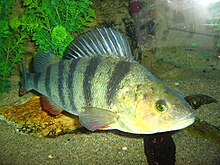European perch
| European perch | |
|---|---|
 | |
 | |
| Conservation status | |
| Scientific classification | |
| Kingdom: | Animalia |
| Phylum: | Chordata |
| Class: | Actinopterygii |
| Order: | Perciformes |
| Family: | Percidae |
| Genus: | Perca |
| Species: | P. fluviatilis |
| Binomial name | |
| Perca fluviatilis Linnaeus, 1758 | |
 | |
European perch are greenish with red pelvic, anal and caudal fins. They have five to nine dark vertical bars on their sides.
European perch can vary greatly in size between bodies of water. Perch can live for up to 22 years, and older perch are often much larger than average; the maximum recorded length is 60 cm (24 in). The British record is 2.8 kg (6 lb 2 oz), but they grow larger in mainland Europe than in Britain, and to as much as 9 kilograms (20 lb) in Australia.[1][full citation needed] As at Nov 2010 the official all tackle world record stands at 1.5 kg (3 lb 5 oz)[clarification needed] although individual records from various areas record larger fish.[2][3]
The perch spawns (in the Northern Hemisphere) at the end of April or beginning of May, depositing the eggs upon water plants, or the branches of trees or shrubs that have become immersed in the water; it does not come into condition again until July. The eggs have been known to stick to the legs of wading birds and then transferred to other waters that the birds visit.[citation needed]
Taxonomy
The first scientific description of the river perch was made by Peter Artedi in 1730. He defined the basic morphological signs of this species after studying perch from Swedish lakes. Artedi described its features, counting the fin rays scales and vertebrae of the typical perch.In 1758 Carl Linnaeus named it Perca fluviatilis.[4] His description was based on Artedi's research.


No comments:
Post a Comment